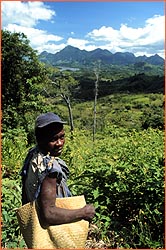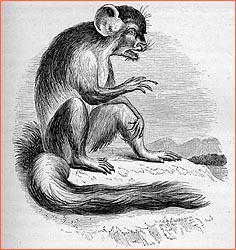 |

|

|
Part 2 | Back to Part 1 Wild men and other monsters The wilderness has its own ghosts, which come in the form of kalonoro, the so-called "wild men of the woods." The belief is pervasive in and around the Marojejy Mountains, which we'll visit on this expedition (see The Mission). Indeed, when I hiked in some hills near the Marojejy massif in 1996, my Betsimisaraka guide told me that wild men lived in the rocky hills and ate nothing but land crabs and fruit. "Kalonoro are by far the most mysterious, frightening, and bizarre (hafahafa) of the Malagasy spirits," writes the anthropologist Lesley Sharp in The Possessed and Dispossessed (University of California Press, 1993). Small of stature, with eyes that glow like coals, long flowing beards, and feet that point backward, the kalonoro live deep in the forest, where they will occasionally appear at hunters' campfires. In the 1889 Proceedings of the Royal Geographical Society, one L. H. Ransome recounts the time ten years before when a wild man was captured near the northeastern town of Maroantsetra: We were informed by a trader from Mauritius, a Mr. Carmes, who saw him, that ... [he] was caught by some Malagasy in the employ of a Manahar trader, while asleep on the branch of a tree, and when taken resisted violently, biting his captors severely; after a few days' confinement, however, he ceased to be aggressive. Mr. Carmes describes him as being a powerfully built man of about five feet nine inches in height, his face and body being thickly covered with long black hair; his mode of walking was peculiar, as he traveled very fast, with his head down, occasionally going on all-fours, his eyes (which resembled in expression those of an animal rather than of a human being) invariably being fixed on the ground. When caught he was perfectly nude, but wore clothes when provided with them. He could never be induced to eat flesh or any kind of cooked food, subsisting entirely on manioc and other roots; nor would he sleep in a recumbent position, but when resting preferred to squat on hands and feet on a stool in a corner of the house. After some weeks he commenced to learn a few words, and by means of these and signs it was understood that he had a father and two brothers in the forest where he was taken. These were found and surrounded by a search party one night, but being disturbed, easily eluded their pursuers, jumping from tree to tree like monkeys and running on all-fours. The captured man died five months after being taken.
Explaining away...or trying to Western skeptics might have answers for all these creatures, humanoid and otherwise. Ghosts are merely the product of vivid imaginations conditioned by millennia of indigenous superstition, they might say. Anthropologists claim to have found no evidence that the aboriginal Vazimba people—or anyone else for that matter—lived on Madagascar prior to the arrival of the first Malagasy around the time of Christ. The story of the kinoly ripping out its victim's liver smacks suspiciously of "Little Red Riding Hood" ("Oh, grandmother, what great big nails you've got!" "The better to rip out your liver with, my child!"), while the wild men might be simply lemurs or perhaps a tenacious legend about a pygmy race thought to live in the interior.
Yet as the paleoecologist David Burney once told me, one should not forget the once-mythical creatures that eventually became the gorilla, the okapi, and so forth. Burney has a reason to remember this. While working in Belo-sur-Mer, a remote port town on the west coast, Burney met villagers who told him about a creature they called the kilopilopitsofy ("floppy ears"), which they had seen in the vicinity as recently as 1976. In its particulars, the animal sounds remarkably like the pygmy hippo, which scientists think disappeared about 1,000 years ago. The villagers also described a large, ground-dwelling lemur that runs in a forward-facing fashion like a baboon. No such creature is known to survive on Madagascar today, though the description answers to at least two types of extinct giant lemur. Could it be that two of the island's extinct megafauna actually survive in the sparsely inhabited, extremely remote dry forests around Belo-sur-Mer? One could extrapolate to ask the same question of other inaccessible and little-visited regions of Madagascar, including the very Marojejy Mountains we'll be trekking into on this journey. Even after centuries of exploration, beginning with the first European sighting of Madagascar in August 1500, exactly half a millennium ago, many areas remain unexplored. Who knows what dwells therein? Peter Tyson is Online Producer of NOVA. Photos: (1) David Parks; (3-5) Peter Tyson. The Expedition | Surviving The Wilds | Explore Madagascar Dispatches | Classroom Resources | E-Mail | Resources Site Map | The Wilds of Madagascar Home Editor's Picks | Previous Sites | Join Us/E-mail | TV/Web Schedule About NOVA | Teachers | Site Map | Shop | Jobs | Search | To print PBS Online | NOVA Online | WGBH © | Updated November 2000 |
 As we looked off toward the Marojejy Mountains, this Malagasy guide told me of the "wild men" who live in the hills, surviving on fruit and crabs.
As we looked off toward the Marojejy Mountains, this Malagasy guide told me of the "wild men" who live in the hills, surviving on fruit and crabs. A pervasive Malagasy fear of snakes such as this native boa may have spawned legends of the fanany, a snake-like animal with seven horned heads.
A pervasive Malagasy fear of snakes such as this native boa may have spawned legends of the fanany, a snake-like animal with seven horned heads. The aye aye, a bizarre nocturnal lemur with the teeth of a beaver, the ears of a bat, and the tail of a fox, was considered fantastic before the first specimens came into European hands. What other Malagasy creatures currently considered fantastic could in fact be real?
The aye aye, a bizarre nocturnal lemur with the teeth of a beaver, the ears of a bat, and the tail of a fox, was considered fantastic before the first specimens came into European hands. What other Malagasy creatures currently considered fantastic could in fact be real?